I'm trying to understand the rules defined by the UML2 metamodel for associations between actors and usecases in usecase diagrams. I understand that actors and usecases can take part in generalizations (because they are derived from Classifier which adds the possibility for generalization), and I understand that an usecase can have extend/include-relationships to other usecases (because it is directly defined in the specification for usecase diagrams). Here is a part of the metamodel diagram for usecases:

As you can see, there are no associations between actors and usecases at all in this diagram. This can only mean that associations are allowed due to a common supertype of actor and usecase, perhaps BehavioredClassifier or Classifier. So my question is:
- Which of the meta(-classes) or elements in the metamodel hierarchy are responsible for associations between actors and usecases?
Another thing which is confusing: there is a constraint that says:
An actor can only have associations to use cases, components, and classes. Furthermore these associations must be binary.
But there is no equivalent constraint defined for usecases (except the binary thing). Does that mean associations always belong to actors and usecases are not aware of their associations towards actors? The specification can be found here, thanks.